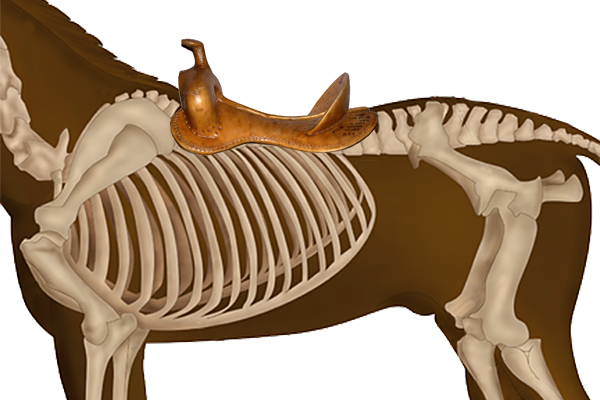|
Proper Saddle Fit - Is It Vital for You and Your Horse's Comfort?

Having a properly fitting saddle for your horse is as important as having properly fitting shoes is for you. A saddle that fits you and your horse well will help him perform to the best of his ability. A poorly fitting saddle is one of the most common causes for back pain. Back pain will result in poor performance and a grumpy horse.
A saddle that fits correctly distributes weight across the horse's back muscles without pinching or sliding. It should allow for free movement of the scapula (shoulder blade) and should not come in contact with the withers or the dorsal spinous processes (DSPs) of the horse's back. The DSPs are the portion of the vertebrae that extend dorsally (up) from the vertebral bodies. They can also be associated with another source of back pain, "kissing spines".
 |
|
 |
Dorsal Spinous Processes |
When the DSPs touch, or impinge on each other, this causes persistent low-grade pain in the affected area of the spine.
The basis of good saddle fit is the tree. Trees are made in different widths from narrow to extra wide. Some saddles have adjustable trees. English saddles are usually made with a wooden or metal tree and have wool or foam flocking in the panels. Wool flocking can be adjusted, which can potentially improve the fit. The tree of a Western saddle, however, is molded or carved so it cannot be adjusted. Pads or shims must be used for adjustment
 of the Western saddle.
How do you know if your saddle does not fit? Some tell-tale signs of poor fit are white hairs, bald spots, temporary swellings after saddle removal, and muscle atrophy on the sides of the withers. Dry patches surrounded by sweaty areas also indicate uneven pressure. Horses may exhibit behaviors which indicate back pain, such as sensitivity to being brushed, crabbiness when saddled, or restlessness when being mounted.
 |
|
 |
Note the white hairs and dry spots in the withers area. |
Resistance to training, such as bucking, rearing, or refusing to go forward can be the result of poor saddle fit. An improper fit can cause pressure points where the tree presses into the back. These pressure points impede proper circulation, hinder proper muscle development, and cause pain. This can even result in lameness as the horse tries to avoid the source of pain and carries himself unevenly. Saddle fit should routinely be investigated as a possible source of back pain.
There are a number of steps to follow in order to evaluate saddle fit:
- Examine the saddle thoroughly off the horse.
- Check the symmetry and soundness of the tree, panels and gullets.
- Look at the condition of the saddle leather, billets, seat wear and leathers.
- Take a look at the structure and muscling of the horse's back.
- Assess how the saddle sits on the horse and how it suits his form. Does it rock? Are there pressure points? Does it interfere with the swing of his shoulder? Does it slide from side to side?
- Run your hand under the panel from the withers back to assess for even distribution of weight.
- Check the withers for adequate clearance from the saddle.
- Finally, ride in the saddle and assess how the saddle suits your needs as a rider. The rider needs to be comfortable and balanced in the saddle as well. Rider imbalance can cause back pain for both the horse and rider.
|
|
| The rider on the left is crooked and out of alignment with her horse. |
Proper saddle fit is essential to your horse's comfort and ability to perform. If you are suspicious that your horse is experiencing back pain, enlist the expertise of your veterinarian, trainer, and professional saddle fitter. The horse's back will change and develop with his fitness and training. Saddle fit will also change and may require twice yearly evaluation. A professional saddle fitter can help with the sometimes confusing process of saddle fit, whether by adjusting your current saddle or helping you find a proper saddle for your horse. This is a worthwhile and important investment in your horse's overall health and well-being.
Happy Holidays from everyone at Genesee Valley Equine Clinic
Save the date !
GVEC's 28th Annual Winter Horse Health Seminar
Saturday February 4, 2017
Wheatland Chili HS, Scottsville, NY
8 am until noon
Free admission
|